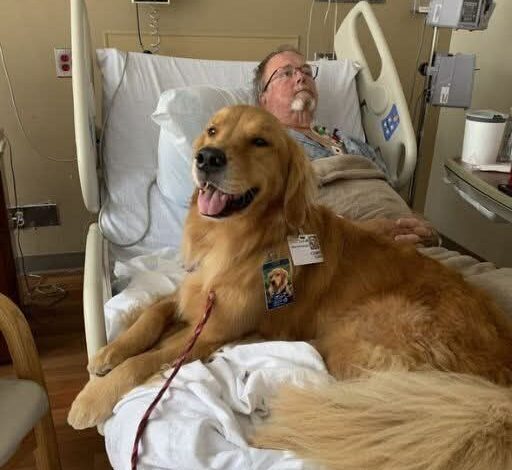When A Therapy Dog Changed Everything: An Emotional Journey of Healing and Connection

His words hung heavy with both joy and sorrow. I sensed there was more to his story—something painful beneath the surface.
“What happened?” I asked, preparing myself for the answer.
His expression darkened momentarily, but instead of retreating into silence, he sighed deeply. “Eleanor passed away two years ago. Cancer took her. They said it was quick, but watching someone you love fade away… time moves differently then.” His hands trembled slightly. “After she was gone, I lost purpose. Stopped talking. Stopped eating. Even the marigolds in our garden withered because I couldn’t bring myself to care for them.”
Tears formed in my eyes as I glanced at the equally emotional nurse. This wasn’t just about a patient reconnecting—it was about a man rediscovering parts of himself that grief had buried.
Riley nudged Mr. Callahan’s arm, bringing him back to the present. The elderly man chuckled softly. “You don’t give up, do you? Just like Eleanor.”
That’s when the profound realization struck me. Perhaps Riley’s presence wasn’t coincidental. Therapy dogs have an extraordinary ability to access emotions we’ve locked away, creating bridges where walls once stood.
As if sharing my thoughts, Mr. Callahan added, “Eleanor always wanted a dog, but our living situation never allowed it. She would have adored him.” He gestured toward Riley, whose tail wagged enthusiastically. “Maybe she guided him to me somehow.”
A comfortable silence fell, broken only by the clock’s steady ticking. It wasn’t a statement of religious belief or supernatural claims—just a man finding solace in the idea that love continues beyond death. That somewhere, Eleanor was still watching over him.
Mr. Callahan surprised me once more. “Could we go outside? I haven’t felt the sun in weeks.” His voice carried both determination and vulnerability.
After confirming with the nurse, I helped him up. With Riley leading our small procession, we slowly made our way to the facility’s garden courtyard. The sunset painted everything in warm golden light. Mr. Callahan observed it all with renewed wonder.
When we reached a bench surrounded by flowerbeds, he stopped suddenly, pointing to bright yellow blooms. “Marigolds,” he whispered, his voice breaking. “They planted marigolds here.”
He sat down and reached out to touch the delicate petals. Tears flowed freely down his face—not tears of grief, but of gratitude and remembrance.
That evening, as I settled Riley into his bed, I reflected on our extraordinary day. The experience wasn’t just about Mr. Callahan speaking again—it was about human connection. About how even in our darkest moments, there’s always a pathway back to light if we’re willing to follow it.
Life inevitably brings losses—of loved ones, dreams, or parts of ourselves. But healing doesn’t require forgetting. Instead, it means discovering new ways to carry those we’ve lost within us. Through memories, flowers, or the unconditional love of a therapy animal, love finds us precisely when we need it most.
The Power of Animal-Assisted Therapy for Seniors
Studies show that animal-assisted therapy can significantly improve quality of life for elderly patients, especially those experiencing depression, isolation, or health challenges. The emotional and physical benefits include reduced blood pressure, decreased anxiety, and increased socialization.
For Mr. Callahan, Riley’s visit did more than just encourage speech—it reopened his heart to healing.
If this story touched your heart, please share it with others who might benefit from this reminder: even in our most profound silence, there always remains the possibility of finding our voice again. ❤️